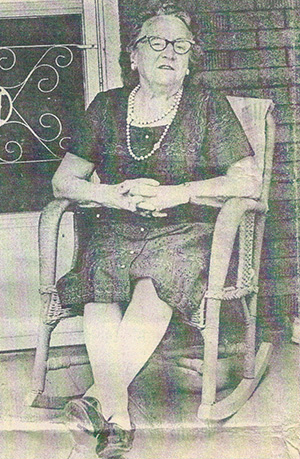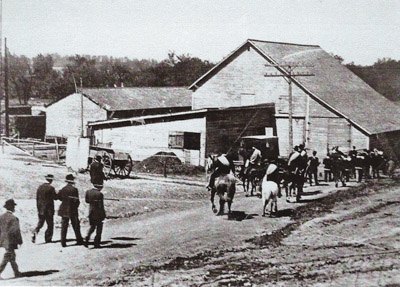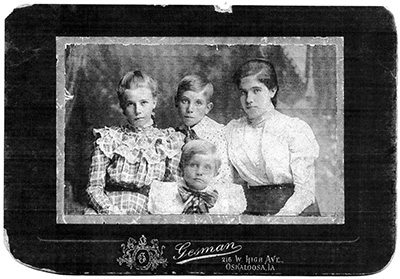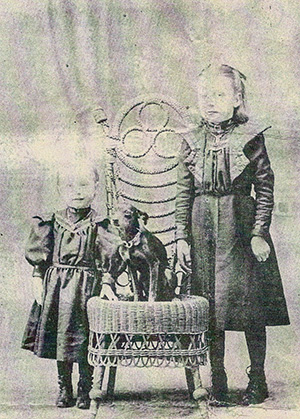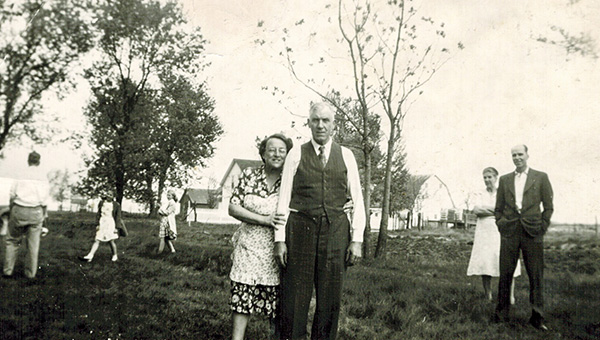
http://www.buxtoniowa.com • Consol, Haydock & Buxton Iowa, USA • 1871 - 2014
The writer Hazel Nylander-Smith (Aunt Hazel) was my dads aunt by marriage to Emma Petersons brother Hjalmer. Hazel and Hjalmer lived in Buxton’s East Swede Town, Eveland (2 miles East of Buxton), on a farm west in Bussey, IA and in later years in the town of Bussey. Hjalmer played for the Buxton Wonders Baseball Team. Article appeared in the Knoxville Express Newspaper Oct. 15, 1973.
Life In A Mining Camp During The Early 1900’s
by Mrs. Hazel Nylander
I wonder if many of you could visualize what life was like in a coal camp around 73 years ago at the beginning of the century.
I was born in Evans, a coal mining camp in Mahaska County. My parents were John and Elizabeth Smith. Most of the men worked in the mine around Evans. But it was not entirely a coal camp since it was also a railroad town with individually owned houses, a store, butcher shops, churches, schools and a saloon. It also had a water tower for the steam locomotives, a turntable and workshop for engines and a coal fueling station.
From Evans we moved to Beacon, which also had a coal camp. I remember my parents saying they were poor while they lived at beacon, for the mines were not working and men marched everywhere seeking work. that summer was known as the summer of the Common Wheelers, as in those days coal miners were looked upon as an inferior people
But in spite of their poverty, they never lost their sense of humor. One neighborhood joke was started when one of the families used an old soup bone long past its usefulness. They put it in a pan of water, placed it on the stove and told the neighbors they were invited over for soup. That soup bone made the rounds of all the homes.
After the mines started operating again, we moved to Colon. We didn’t live in one of the camp houses, but a house owned by Tom and Mollie Hart, who were my good friends. Mama and Molly wrote to each other as long as they lived. I played with the Hart children. Molly and Babe, who are now deceased, and Ralph, their brother, who now lives in Attica. My sister, Myrtle was born when we lived in Colon.
My uncle and aunt, Mr. and Mrs. John Price, purchased a farm near the Skunk River and we moved there and Papa became a farmer. I enjoyed living on the farm and started school there. When I was past nine, the Prices invested in coal mining and sold the farm; so it was back to the coal mines for us.
This mining camp was called Eveland. It was about a mile and a half from old Buxton and was located on the “K” road. I remember the day we moved. I had never seethe coal camp and how disappointed I was! It was just two rows of houses on each side of the road and nothing else; no store - nothing but houses.
Our farmer friend moved us with horses and wagons, but Mother, my sisters, Myrtle and Mary, and I went in our buggy. We went by Evans and left baby Mary with aunt Lizzie Price, and we arrived about the same time as our furniture. We moved into a four-room house. After the farmers had fed and watered their horses, they helped Papa put up the stoves, and while Mama prepared food for them they moved in the rest of the furniture and put up the beds. After eating, they returned home, and to my knowledge we never saw them again.
Mother then made the beds, and tried to restore order. After a lunch we retired early as all were tired. In the morning Papa went to work at the mines and I became acquainted with the other children and inquired about school.
There was only one well in the camp, and it supplied water for everyone. Water was drawn up with an oaken bucket and carried by bucket to each home.
We had to cross the fields by foot to a country store operated by an elderly couple, Mr. and Mrs. William Johnson. They also had the post office, but people didn’t correspond as much then or get papers as they do now. The first magazine I can remember was the Grit. Mr. Johnson drove a buckboard three or four times a week to pick up groceries and mail at Oskaloosa. He would also carry passengers. Later they built a store at Eveland. The Prices eventually built themselves a home, a store, ice house, pool hall, and dance hall combined.
The Moore children, Mattie, Earl and Perrin, who lived on a farm close to the camp, were my friends. I went to the store often with Mattie.
Later we again moved to a farm house on a farm my uncle bought from Mr. and Mrs. John Moore. Their son, Ray, now lives in Knoxville. This house also had only four rooms, but it had a large pantry and a summer kitchen. Women cooked the year around on the cook stove and believe me, the houses got unbearably hot in the summer. But Papa moved out cook stove to the summer kitchen every spring and our home wasn’t so hot.
Our front bedroom had two beds, one for our parents and one for we girls. People didn’t have private bedrooms as they do now. The beds were equipped with a flat spring, no box springs or fancy ones, and each bed had a straw tick. That is a tick the mothers made and stuffed with straw. Every summer the straw tick was washed and restuffed. Papa would go out to a farmer and agree on a price for the straw. The farmer would then loan him a team and hayrack to bring the stuffed ticks home. We children thought this was fun, for Papa would always put some straw on the hayrack so the tick wouldn’t get dirty. What fun it was to sleep on the fresh bed. It was so high, but by the next year it was worn down pretty thin. Mama was the proud possessor of a feather bed for which she had saved chicken feathers when we lived on the farm, and also even the nice soft ones from the quail Papa killed. I think out home was the only one at that time with a feather bed.
As there were no closets, our clothes were hung on the wall at the foot of the bed where Papa put up a wide shelf and Mama made a calico curtain to hand on it to keep the clothes from getting dusty.
Our front room was very nice. Mama had made a rag carpet to cover it. She cut rags and I sewed them and we were very proud of it.
She would sprinkle the extra straw on the floor and tack the carpet down. This straw made the floors warmer and the straw collected the dust that filtered through. We had no carpet sweepers, just a broom, so, with my Mother’s beautiful old dresser, her marble-topped stand, a couple of rockers, the baby’s cradle and lace curtains at the window, we thought it was beautiful.
After our rag carpet wore out, Papa bought us a wool ingrain carpet. How beautiful we thought it was with its big flowers and leaves and bright colors. It was lighter on one side than the other and every spring Mama would put up the light side, then the dark side up for winter. She would hand it over the clothesline and we children would help her beat out the dust with a carpet beater.
Our back bedroom had two beds and a dresser. The clothes were hung on the walls and the floor was bare, as in the other bedroom.
Our kitchen floor was also bare and Mother would get down on her knees every Saturday and scrub it with hot water, using a brush and soap. If it became soiled through the week she did it again. Also every Saturday the cookstove was polished, along with the table, chairs, cupboard and a shelf for the kerosene lamps. The lamps would be cleaned, filled with oil, and newly-cut wicks put in them. The lamp chimneys were washed and shined everyday in our kitchen.
The kitchen had a pantry for dishes, pots and pans; with a flour barrel and sugar jar. In spite of limitations, our kitchen was very neat and when spring came the cookstove and heater were moved to the shanty where Mama did all the cooking and ironing.
In the evening Mama would heat the water for the men folk to bathe when they came home from work. There was always a wash boiler of water on the back of the stove for washing clothes and bathing. Clothes were washed in a tub and scrubbed on a washboard. In summer it was a very hot job and Mama would wet to below her waist with perspiration, but she never complained.
I know we girls always had our hair washed on Saturday nights. First she would wash our faces and hair and then braid it. Then we would bathe, or as we said “wash all over.” Mother would lay out all of our clean underwear and night gowns. She started with the smallest and ended with me. We all used the same water, and after we were clothed and tucked into bed, it was Mama’s turn to “wash all over.”
In those days, men didn’t dress as dapper as today as there wasn’t any place to go through the week. Only on Sunday, and then it was to church. There was an old cliche of “Put on, take off and going without”, when they described clothes. We had plenty of warm clothes and calico dresses and a Sunday dress. No shorts or T-shirts, just common clothes.
Mother had long hair, which she wore in a bun, as there were no beauty shops or home permanents. Her dress for every day was called a Mother Hubbard, made like the one women wear during pregnancies, but it touched her shoe tops. My mother always wore a tie apron over her dress, with a bow in the back. Her apron was used for lots of things. If our baby sister was injured, Mother would wipe her face with the corner of her apron, wrap her in it and then let her sleep on the feather bed. We always accused her of cheating as she wasn’t always hurt, but would run to Mother for sympathy and to sleep on Mother’s bed.
On wash day, if at home, I would take a bucket of hot suds and scrub out the privy. I think everyone in those days did it just like you clean your bathroom now.
Food was different then. I don’t remember ever having bananas when I was small, and oranges only at Christmas time. Bread, pies, and cake were always homemade.
Mama baked the best white raisin and graham bread. Many children these days don’t know how good a slice of fresh bread with homemade butter and sprinkled with brown sugar can taste.
Living on a farm, we had chickens, cows and always fattened out a pig to butcher, giving us a variety of food. Miners of that era did not have gardens, for they always said, “What is the use of a garden as we may have to move before we get any use of it.” But Mama and Papa knew they would be there permanently so they always had a large garden and always bought a small pig in the spring and fed it for winter butchering. During the summer it was my job to pull a basket of weeds for Sukey, the pig. (We called them all Sukey). I don’t know if we put any fat on them but it kept me and my friends out of mischief. For a while after pulling weeds, we would climb in the pen and each of us would take a corncob and scratch Sukey oh his stomach or behind his ears until he was content and would lay down and go to sleep.
We would look for other things to do while Sukey slept. It was also my job to feed and water the chickens and gather the eggs.
In those days people “set hens” to raise baby chickens, and after Mama had set all of them it was my job to put the “old setters”, as we called them, in a pen that Papa had built for that purpose.
One day I conceived the idea that if I would dunk the hens in a bucket of water it would take out all desire of raising a family, so my friends and I dunked the old hens. You know a hen can be out in a hard rain and the water won’t make her wet as she keeps her feathers oiled, but when you turn a chicken upside down the feathers will part and believe me that old hen was laughable as she stood there soaking wet and gasping for breath. We shrieked with laughter, but Mama came out and when she saw what we had done, she slapped right and left, and whoever was in the way “got it.”
We didn’t have a bakery, so Mama baked all our cakes and pies, which included apple, raisin, currant, dried apple, dried peach, and custard. Also, Mama used cooked fruit in puddings.
With meat, eggs, fried chicken, rabbits, squirrels, and quail in season, we had a variety of meats.
Vegetables included potatoes, turnips, and carrots stored in the cellar. Lima and soup beans were dried. We had a good living, but not fancy.
Mother made lots of cottage cheese, tomato, grape and plum preserves and apple butter, so one didn’t have to go to the store often, and of course, people made homemade ice cream in the winter. After Uncle John put up and ice house, we had ice cream in the summer, too.
You might think we didn’t have much enjoyment, but I beg to differ. In the winter we would ice skate and had sleds. In the summer we had wooded areas to wander in, flowers to pick, and creeks to wade in. We had something that youngsters of today will never know.
My Papa loved circuses, and he and I saw all the big top shows including Ringling Brothers, Barnum and Bailey and Buffalo Bill’s. We always went early in time for the parade. We would stand on the sidewalk and watch it go by. First came the circus band on a large platform drawn by horses. The musicians were dressed in red coats and caps. Then came the horses ridden by lovely - dressed ladies, some of the performers walking, and the elephants, followed by camels, zebras, clowns and all the wild animals in their cages drawn by horses. The big hippopotamus in his water tank came next, then the fat lady, the tattooed man and at the end, the steam calliope playing so loudly it could be heard for miles. To see Buffalo Bill astride a beautiful white horse dressed in his big white hat and white outfit and white hair was a thrilling experience for me. And then to top it all was Annie Oakley, stinging up in her saddle, riding fast around the ring and shooting and breaking glass balls that were thrown in the air. I don’t think her act was ever duplicated. I always wished I could grow up and be like her. Papa and I would first visit the animal tent, then the side show with the fat lady, the tattooed man, the sword swallower and all the rest. Then the big top with three rings, all going at once, the trapeze and high wire acts, the clowns and all. It was wonderful! When all was over we drove 18 miles back home. I always fell asleep before we arrived.
So you see, these are just a few of the things that happened when I was young. One can’t live them again, but only write about them, and experience pleasure in the memory.
